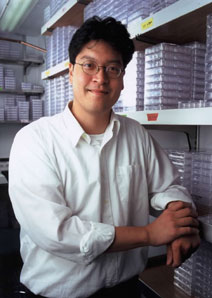Young Faculty Member Tackles Tough Structures
By Jason Socrates Bardi
One Monday morning at 8:00 AM, Assistant Professor Geoffrey
Chang, Ph.D., is busy in his laboratory tending to a fermenter
full of churning cells. In the corner of his office lies a
crumpled sleeping bag, recently used. Chang admits that, unlike
a few years ago, he needs to nap sometimes when tending to
his longer experiments. "I’m not that young anymore,"
he says.
One of The Scripps Research Institute’s (TSRI) young
faculty, Chang, 29, arrived at the Department of Molecular
Biology just over a year ago to pursue membrane protein crystallography.
He is particularly interested in the structures of several
types of membrane transporters. One of these, the drug efflux
pumps, may be an important system for deterring the threat
of antibiotic-resistant bacteria and addressing the related
problem of the sometimes low efficacy of chemotherapy.
Efflux pumps are broad-based defense mechanisms that bacterial
and cancerous cells use to resist pharmaceuticals, transporting
the drugs out of the cell. "We actually have very good drugs
to fight cancer and to kill bacteria," says Chang, "[but]
they can’t always get in the cells to work."
One of the eventual goals is the development of a new class
of drugs that patients would take in conjunction with antibiotic
or chemotherapeutic agents to keep those drugs in the cells
and increase their efficacy. Such "pump inhibitors" could
potentially enhance many other drugs on the market as well.
There are, already, some efflux pump inhibitors commercially
available. "It would be very interesting to know the structure
of a pump with one of these inhibitors, and use that as the
basis for making the inhibitor more potent," says Chang. "That’s
why we’re actively trying to get the structures done.
Nobody knows what the structure of any of these pumps are."
Department of Molecular Biology chairman Peter Wright attributes
the unfamiliarity to the adolescence of this area of research,
and he looks forward to the growth of the field at TSRI under
Chang. "He has a new methodology that will dramatically increase
the chances of success," says Wright, "and we’re excited
to have him."
Out of Our Antibacterial Paradise
At the dawn of the 20th century, bacterial infections accounted
for several of the leading causes of death in the United States.
By the middle of the century, many had begun to believe that
the threat had waned. Bacterial infections that in 1900 topped
the list as leading causes of death in the United States were
no longer even among the top ten. After Alexander Fleming
discovered penicillin in 1928, it—along with all the
other "wonder drugs" that followed—toppled tuberculosis
(TB) and typhoid fever, controlled cholera and gonorrhea,
reduced staphylococcal dysentery infections, and lowered the
incidence of many other pandemic bacterial infections. At
least partly because of these antibiotics, the average life
expectancy in the United States has risen from 47.3 years
in 1900 to almost 80 years today.
But the tide is turning again. Several bacteria have developed
the ability to resist antibiotic treatment, including M. tuberculosis,
E. coli, N. gonorrheae, S. dysenteriae, various types of pneumococci,
cholera and typhoid bacilli, and Salmonella enteritis. Bacteria
once contained by drugs are now outstripping the ability of
drugs to contain them. "What’s happening today," says
Chang, "is that a lot of these diseases are coming back."
These diseases are coming back resistant to the antibiotics
that have been used to treat them for years, and people who
are infected with these resistant strains have to be treated
with alternative antibiotics, as they have over the last decade.
Now multiple drug-resistant bacteria are emerging as an
even greater threat. Multiple drug-resistant TB is no longer
susceptible to broad categories of antibiotics, such as the
RNA synthesis inhibitor rifampicin, the cell wall synthesis
inhibitor isoniazid, and streptomycin, which inhibits the
30 S subunit of the bacterial ribosome. Certain strains of
S. dysenteriae, a common hospital pathogen, have even become
resistant to all but one single drug—the quinolone ciprofloxacin—and
may soon become completely untreatable.
Treating multiple drug-resistant bacterial infections can
be a hundred times more expensive than treating normal infections,
and the World Health Organization estimates the total cost
of treating all hospital-borne antibiotic resistant bacterial
infections is around $10 billion a year. Worse, with rapid
transit, open borders, and world travel being what they are,
multiple drug-resistant bacteria could potentially spread
beyond the isolated confines of a hospital and into populations.
The greatest fear of all is the grim prospect of a multiple
drug-resistant bacterial epidemic.
1 | 2 |

|

One of the youngest of TSRI's faculty, Geoffrey Chang,
pursues membrane protein crystallography.
|

